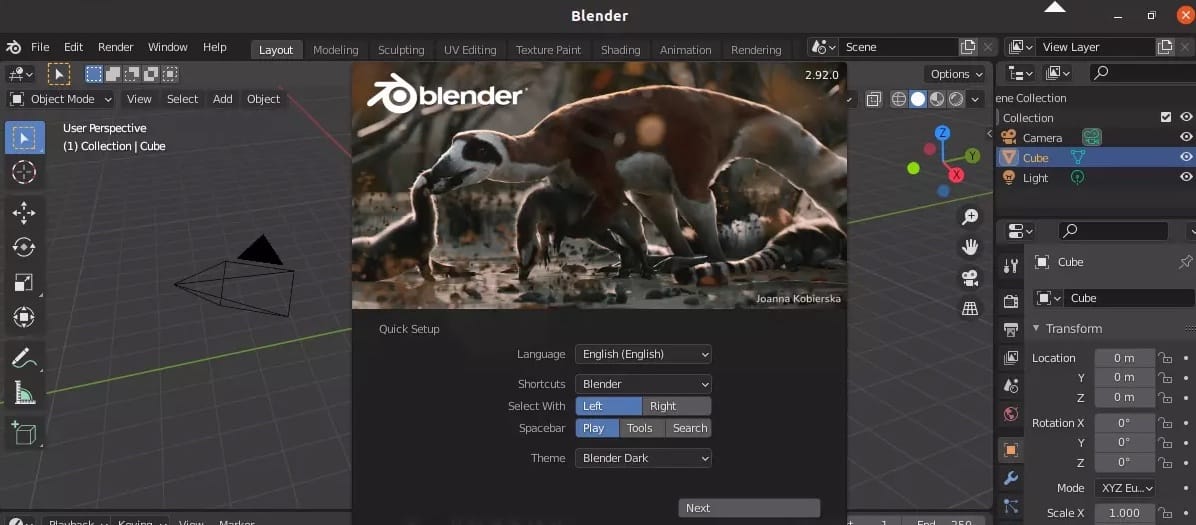How To Install Blender on AlmaLinux 9

Blender is a powerful open-source software suite for 3D modeling, animation, rendering, and more. It is widely used by artists, designers, and developers for creating stunning graphics and animations. Installing Blender on AlmaLinux 9 can enhance your creative projects significantly. This guide provides a comprehensive walkthrough for installing Blender using various methods, ensuring that users of all skill levels can successfully set it up on their systems.
System Requirements
Before diving into the installation process, it’s essential to ensure that your system meets the necessary requirements for running Blender efficiently.
Minimum Requirements
- CPU: 64-bit dual-core processor.
- RAM: At least 4 GB.
- GPU: Graphics card with OpenGL 2.1 support.
- Operating System: AlmaLinux 9 or compatible Linux distribution.
Recommended Requirements
- CPU: Quad-core processor or better.
- RAM: 16 GB or more.
- GPU: NVIDIA or AMD graphics card with at least 4 GB of VRAM.
- Storage: SSD recommended for faster load times.
Installation Methods Overview
This article outlines three primary methods for installing Blender on AlmaLinux 9:
- Using the Package Manager
- Using Snap
- Manual Installation from a Tarball
Method 1: Installing Blender via Package Manager
The simplest way to install Blender on AlmaLinux is through the system’s package manager. This method ensures that you have the latest stable version available in the repositories.
Step-by-Step Guide
- Open the Terminal: You can find the terminal application in your applications menu or use the shortcut
Ctrl + Alt + T. - Update Your System: Before installing any new software, it’s good practice to update your package list. Run the following command:
sudo dnf update - Install Blender: After updating, install Blender by executing:
sudo dnf install blender - Verify Installation: To confirm that Blender has been installed successfully, type:
blender --versionThis command will display the installed version of Blender.
Pros and Cons
The package manager method is straightforward and integrates well with your system’s update process. However, it may not always provide the latest version of Blender. If you require cutting-edge features, consider alternative installation methods.
Method 2: Installing Blender via Snap
If you prefer a more flexible installation that allows for easy updates and rollback options, using Snap is an excellent choice. Snap packages are self-contained and include all dependencies required to run the software.
Step-by-Step Guide
- Ensure Snap is Installed:
If Snap isn’t installed on your system, you can install it using:sudo dnf install snapd - Create a Symbolic Link:
To enable Snap commands to work properly, create a symbolic link:sudoln -s /var/lib/snapd/snap /snap - Install Blender Using Snap:
Now you can install Blender by running:sudo snap install blender --classic - Verify Installation:
Check if Blender has been installed correctly by entering:blender --version
Pros and Cons
The Snap method provides automatic updates and easy installation of dependencies. However, some users may experience slower startup times due to the containerization of Snap packages.
Method 3: Manual Installation from Tarball
This method gives you complete control over the installation process. It’s ideal for users who want to run the latest version of Blender directly from its source files.
Step-by-Step Guide
- Download the Latest Version of Blender:
Use wget to download the latest tarball from the official site:wget https://ftp.nluug.nl/pub/graphics/blender/release/Blender2.93/blender-2.93.0-linux-x64.tar.xz - Extract the Downloaded File:
Once downloaded, extract it using:tar -xvf blender-2.93.0-linux-x64.tar.xz - Navigating to the Extracted Directory:
Change into the directory where Blender was extracted:cd blender-2.93.0-linux-x64/ - Run Blender:
Launch Blender by executing:./blender - Create a Desktop Entry (Optional):
For easier access, create a desktop entry file in `~/.local/share/applications/` with the following content:``` [Desktop Entry] Name=Blender Exec=/path/to/blender/blender Icon=/path/to/blender/icons/blender.png Type=Application Categories=Graphics;3DGraphics; ```
Replace `
/path/to/blender/` with your actual path to the extracted folder.
Pros and Cons
The manual installation method allows access to the latest features and performance improvements immediately after release. However, it requires manual updates and dependency management, which may be challenging for less experienced users.

Troubleshooting Common Issues
If you encounter issues during installation or while running Blender, here are some common problems and their solutions:
- Error: Missing Dependencies:
If you receive an error regarding missing libraries or dependencies when launching Blender, ensure that all required packages are installed. You can find dependency information on the official Blender website or forums. - Error: Graphics Driver Issues:
If Blender fails to start or crashes unexpectedly, it might be due to outdated graphics drivers. Ensure that your GPU drivers are up-to-date by checking your manufacturer’s website (NVIDIA or AMD). - Error: Snap Not Starting:
If you encounter issues with Snap installations, verify that Snap is properly configured by checking its status with:snap list - Error: Permissions Issues:
Ensure that you have appropriate permissions to run files in the extracted directory if using manual installation. - No Sound Output in Blender:
If you experience sound issues while using Blender, check your audio settings in both your operating system and within Blender’s preferences.
Congratulations! You have successfully installed Blender. Thanks for using this tutorial for installing the Blender 3D modeling on AlmaLinux 9 system. For additional or useful information, we recommend you check the official Blender website.